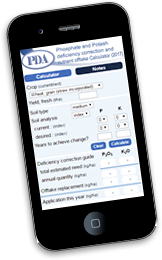PDA News
The PDA publishes both technical News items and shorter Blog items. PDA News provides the latest up to date information on macronutrients and their use, while blog items are shorter and timelier.
If you are in the UK or Ireland and are interested in receiving PDA News items through the post or by email free of charge, then sign up on the contact page. Recipients can receive CPD points for BASIS and NRoSO.
Impact of price on nutrition decisions
July 2022
In such uncertain times placing greater scrutiny on all inputs is understandable. However, farmers must be careful not to reduce inputs which are crucial but, like potash, whose benefits are not visual or directly obvious.
Potash and sugar beet
March 2022
During the last four decades, yields of clean beet and sugar in the UK have been increasing linearly, at an average annual rate of 0.8 t/ha of clean beet. In this article, we consider if the currently recommended potash application rates are adequate to support this.
Potassium and nitrogen interactions in crops
December 2021
Nitrogen has hit the headlines in the last few months, not just within agriculture, but across the mainstream media on the back of factory closures. Within agriculture the focus has clearly been on the steep price rises and the resulting impact on the economic optimum rates. These calculations are wholly justified, but as is often the case, are very singular focussed.
Crop establishment
September 2021
Establishment is the most critical period in any annual crops life-cycle, as it is the time when the yield potential is set. All challenges the crop faces during the season serves to reduce the final yield from this potential. Therefore, conversely, any management decisions taken from this point onwards only helps limit the reduction in this yield potential.
The situation regarding P&K balances
June 2021
When looking at P&K balances in detail over the last five years, including fields where no applications were made, the overall balances are dramatically negative. Maintaining soils at the target index is the safest way to ensure these crops are able to access the required quantities at the appropriate times to optimise growth, yield and therefore financial returns.
Nutrient Use Efficiency
March 2021
Nutrient, particularly nitrogen, use efficiency (NUE), is a particular talking-point currently within the industry as government considers ways to help reduce the impact of agriculture on greenhouse gas emissions. The Campaign for the Farmed Environment states the aim as more efficient nutrient management to reduce greenhouse gas emissions, through better fertiliser application and management of […]
Soil sampling under different cultivation practices
December 2020
The premise for ensuring crops and grass have access to sufficient quantities of phosphorus and potassium to meet their uptake requirements over the course of a season is to assess the soil reserves. This is carried out in practice by taking a soil sample, either to 15cm depth in arable soils, or 7.5cm depth in […]
Potassium and pest pressure
October 2020
Barley yellow dwarf virus is the most economically important virus in UK cereals, with severe infections causing losses of up to 60% in winter wheat and 50% in winter barley. Although this is rare, significant economic damage can occur from small populations of aphids carrying the virus. The effects of BYDV can also be exacerbated […]
Potash for grass
June 2020
Many farmers are not getting the best from their grassland because of a lack of potash. Any green material removed from fields also removes large quantities of potash which will need replacing to ensure grass productivity is maintained.
Crop root systems explain need to maintain K Index level
March 2020
When considering the appropriate soil K Index for a crop or rotation it is important to take into account that different crops have root systems with different total lengths, depths and efficiencies. Generally speaking, the longer an annual crop is growing, the longer the root system, which means that winter combinable crops and grass etc, should have […]
Recent trends in UK potash fertiliser use
December 2019
The latest Professional Agricultural Analysis Group (PAAG) UK soil analysis data suggest that 33% of fields (including both arable and grassland) are below index 2- for potassium. These soils will require an application of K to replace what has been removed by the crop during the season and an additional amount to build up the […]
Potash implications of baling straw
September 2019
Last harvest there were quite a lot of last-minute decisions to bale as a result of anticipated straw shortages and higher prices. Baling and removing straw, where there is no specific requirement for other enterprises on the farm, can often be a sensible agronomic and economic decision. These include high level of residue on the […]

